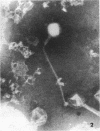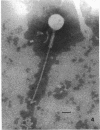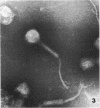Abstract
These studies show that Clostridium botulinum types C and D cultures can be cured of their prophages and converted to either type C or D depending on the specific phage used. Strains of types C and D were cured of their prophages and simultaneously ceased to produce their dominant toxins designated as C1 and D, respectively. Cured nontoxigenic cultures derived from type C strain 162 were sensitive to the phages from the toxigenic type C strain 162 and type D strain South African. When cured nontoxigenic cultures derived from strain 162 were infected with the tox+ phages from the 162 strain of type C and the South African strain of type D, they then produced toxin neutralized by types C and D antisera, respectively. Cured nontoxigenic cultures isolated from the type D South African strain were only sensitive to the parent phage, and, when reinfected with the tox+ phage, they produced toxin neutralized by type D antiserum. Type C strain 153 and type D strain 1873, when cured of their respective prophages, also ceased to produce toxins C1 and D, but, unlike strain 162 and the South African strain, they continued to produce a toxin designated as C2. When the cured cultures from strains 153 and 1873 were infected with the tox+ phage from type D strain 1873, the cultures simultaneously produced toxin that was neutralized by type D antiserum. When these cured cultures were infected with the tox+ phage from type C strain 153, the cultures produced toxin that was neutralized by type C antiserum. These studies with the four strains of C. botulinum confirm that the toxigenicity of types C and D strains requires the continued participation of tox+ phages. Evidence is presented that types C and D cultures may arise from a common nontoxigenic strain.
Full text
PDF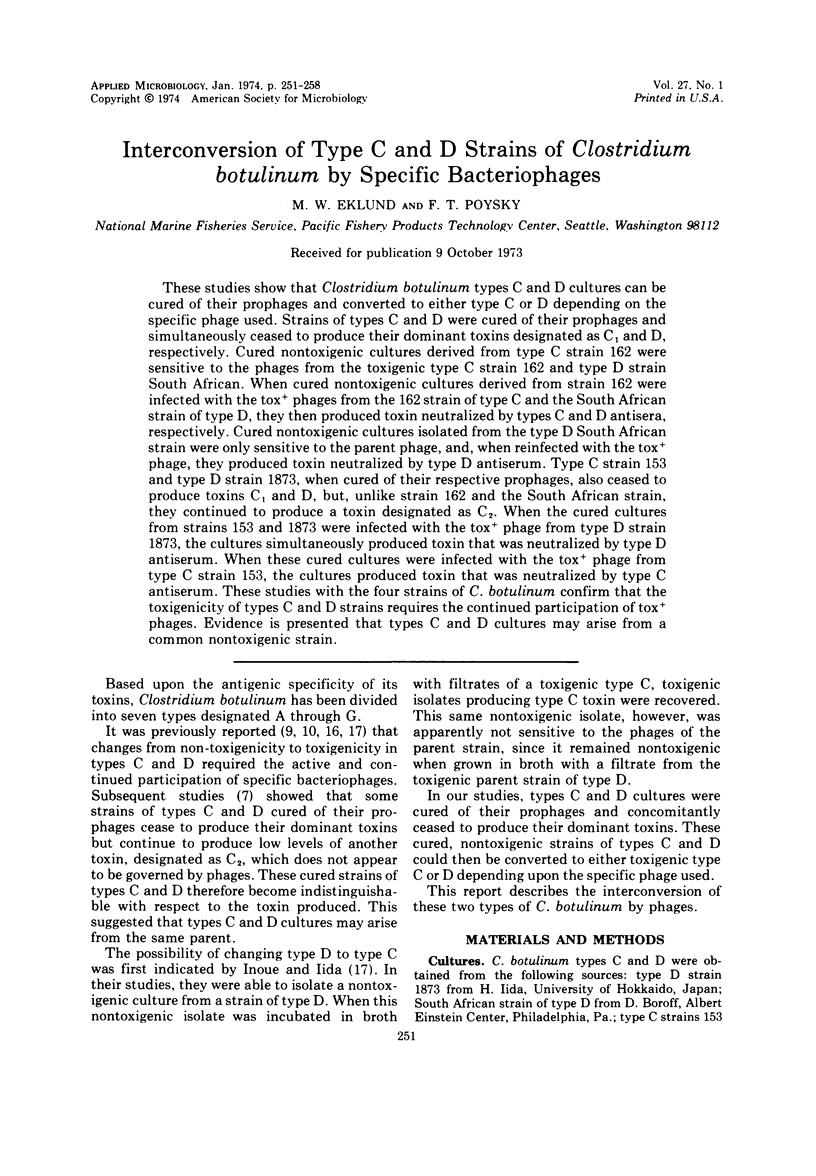
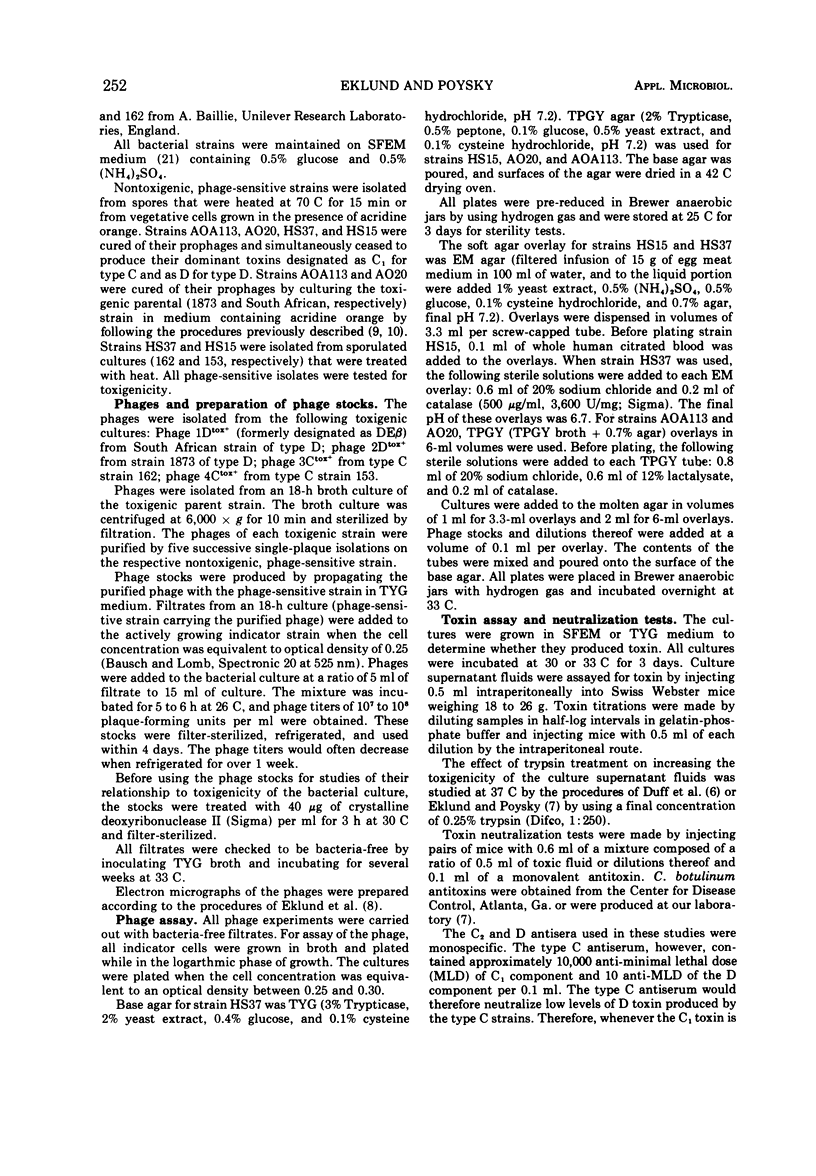
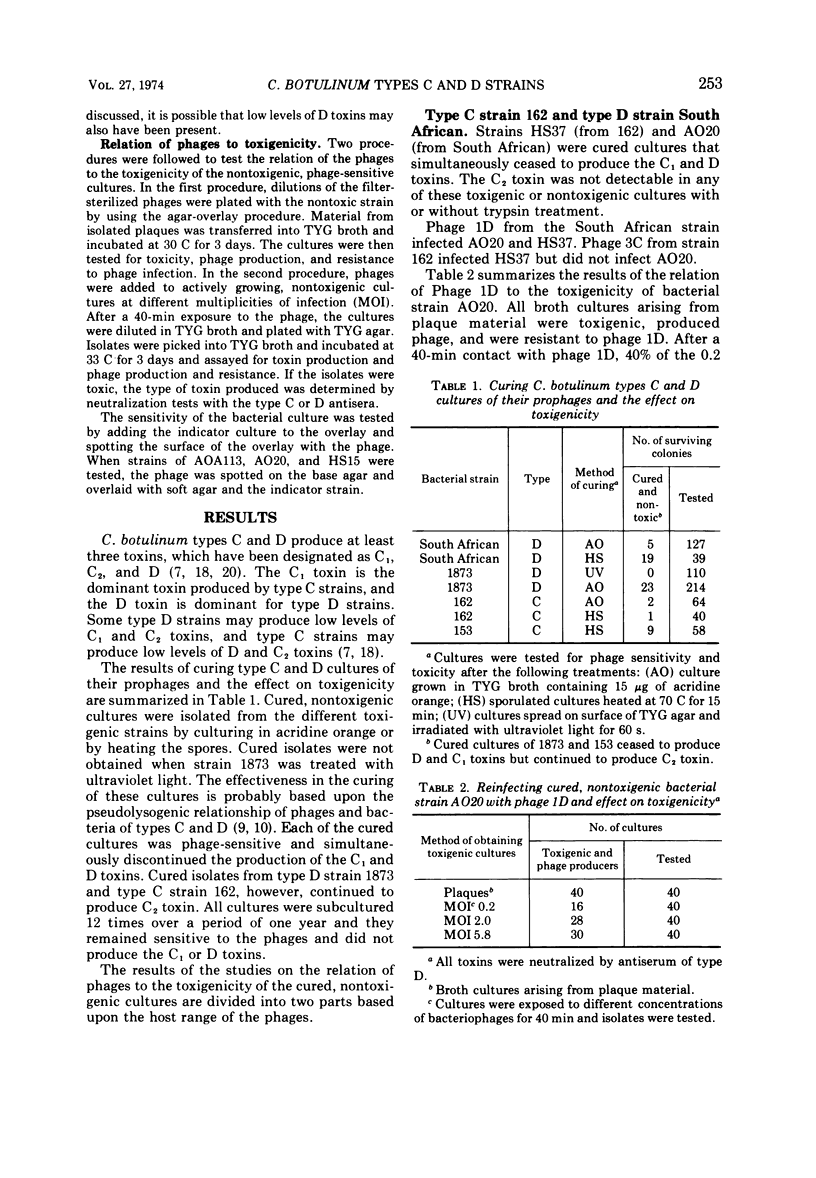
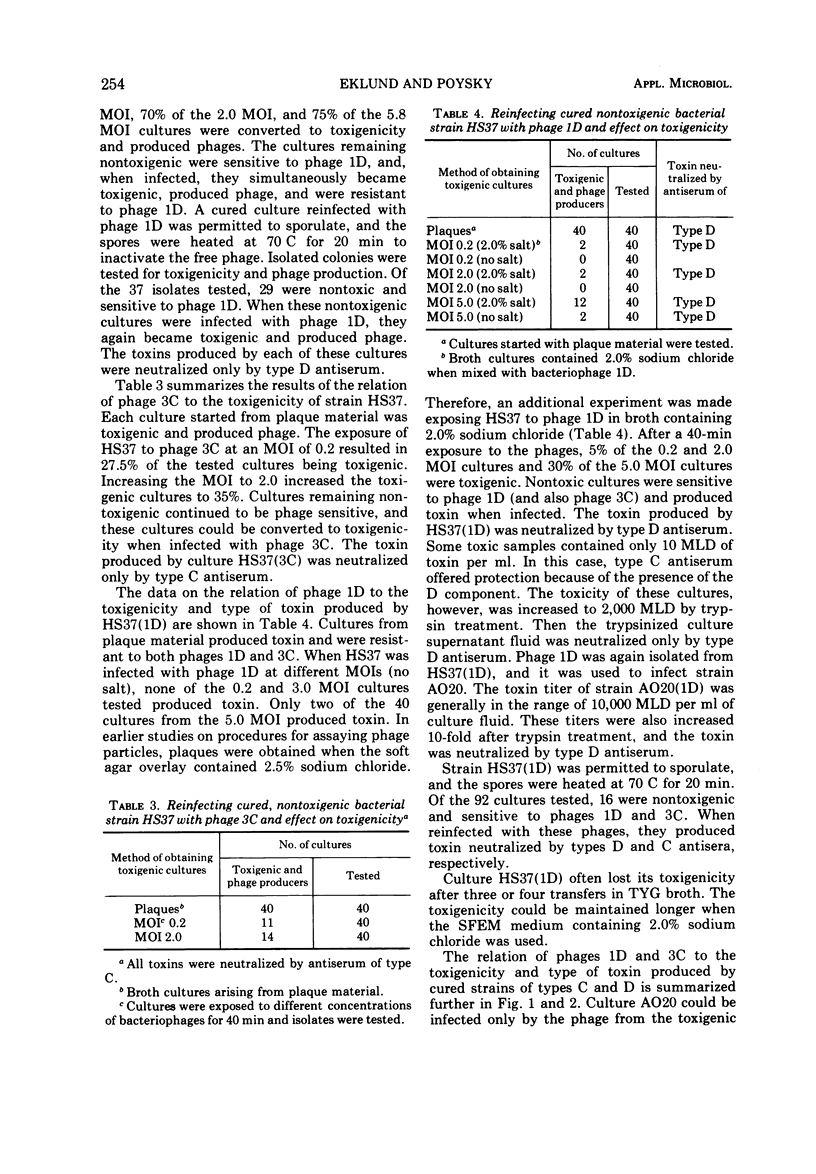
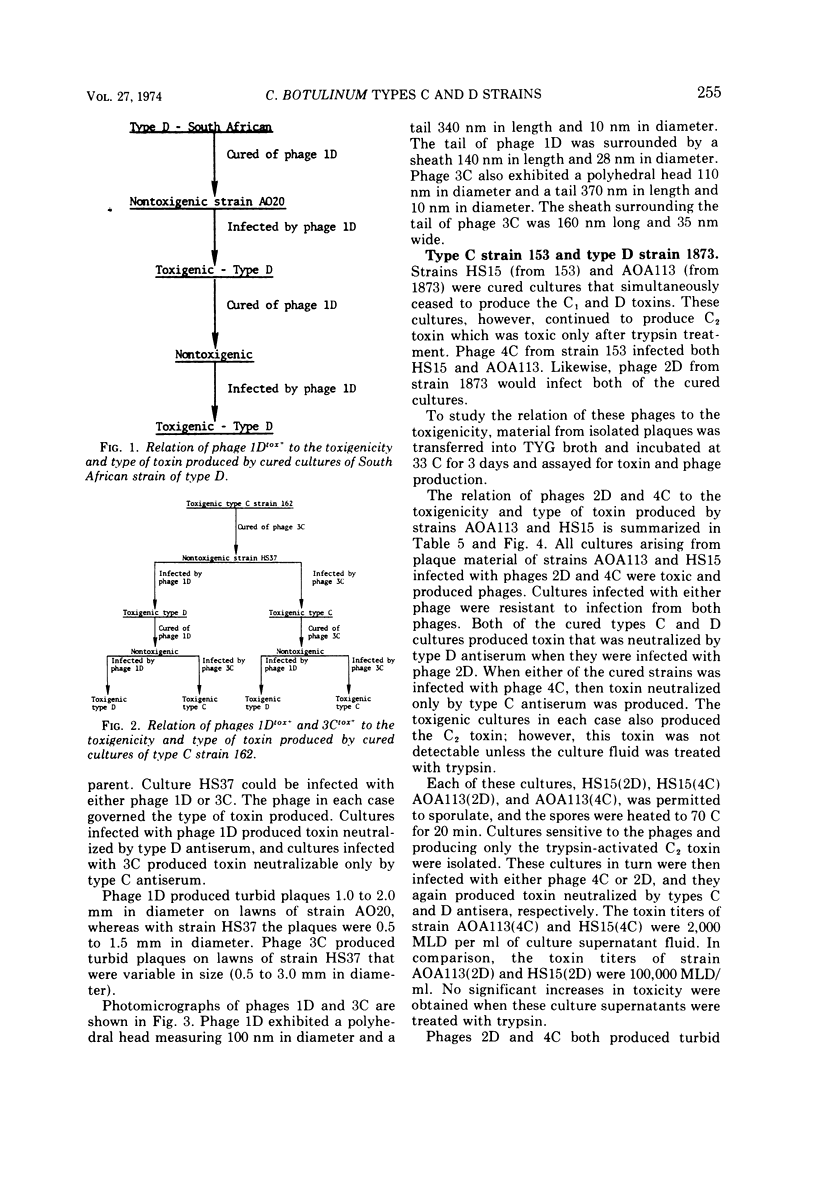

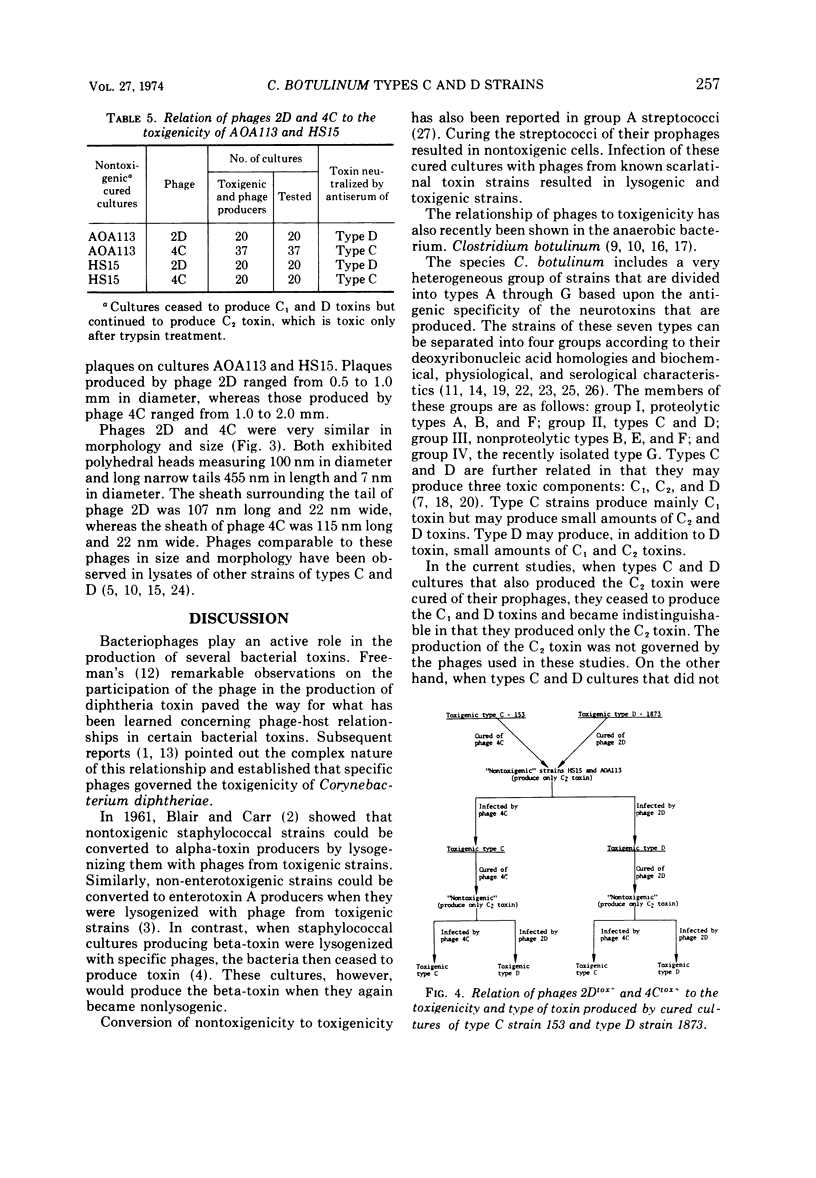

Images in this article
Selected References
These references are in PubMed. This may not be the complete list of references from this article.
- BARDSDALE W. L., PAPPENHEIMER A. M., Jr Phage-host relationships in nontoxigenic and toxigenic diphtheria bacilli. J Bacteriol. 1954 Feb;67(2):220–232. doi: 10.1128/jb.67.2.220-232.1954. [DOI] [PMC free article] [PubMed] [Google Scholar]
- BLAIR J. E., CARR M. Lysogeny in staphylococci. J Bacteriol. 1961 Dec;82:984–993. doi: 10.1128/jb.82.6.984-993.1961. [DOI] [PMC free article] [PubMed] [Google Scholar]
- Casman E. P. Staphylococcal enterotoxin. Ann N Y Acad Sci. 1965 Jul 23;128(1):124–131. doi: 10.1111/j.1749-6632.1965.tb11634.x. [DOI] [PubMed] [Google Scholar]
- DUFF J. T., WRIGHT G. G., YARINSKY A. Activation of Clostridium botulinum type E toxin by trypsin. J Bacteriol. 1956 Oct;72(4):455–460. doi: 10.1128/jb.72.4.455-460.1956. [DOI] [PMC free article] [PubMed] [Google Scholar]
- Dolman C. E., Chang E. Bacteriophages of Clostridium botulinum. Can J Microbiol. 1972 Jan;18(1):67–76. doi: 10.1139/m72-011. [DOI] [PubMed] [Google Scholar]
- Eklund M. W., Poysky F. T. Activation of a toxic component of Clostridium botulinum types C and D by trypsin. Appl Microbiol. 1972 Jul;24(1):108–113. doi: 10.1128/am.24.1.108-113.1972. [DOI] [PMC free article] [PubMed] [Google Scholar]
- Eklund M. W., Poysky F. T., Boatman E. S. Bacteriophages of Clostridium botulinum types A, B, E, and F and nontoxigenic strains resembling type E. J Virol. 1969 Feb;3(2):270–274. doi: 10.1128/jvi.3.2.270-274.1969. [DOI] [PMC free article] [PubMed] [Google Scholar]
- Eklund M. W., Poysky F. T., Reed S. M. Bacteriophage and the toxigenicity of Clostridium botulinum type D. Nat New Biol. 1972 Jan 5;235(53):16–17. doi: 10.1038/newbio235016a0. [DOI] [PubMed] [Google Scholar]
- Eklund M. W., Poysky F. T., Reed S. M., Smith C. A. Bacteriophage and the toxigenicity of Clostridium botulinum type C. Science. 1971 Apr 30;172(3982):480–482. doi: 10.1126/science.172.3982.480. [DOI] [PubMed] [Google Scholar]
- Eklund M. W., Poysky F. T., Wieler D. I. Characteristics of Clostridium botulinum type F isolated from the Pacific Coast of the United States. Appl Microbiol. 1967 Nov;15(6):1316–1323. doi: 10.1128/am.15.6.1316-1323.1967. [DOI] [PMC free article] [PubMed] [Google Scholar]
- FREEMAN V. J. Studies on the virulence of bacteriophage-infected strains of Corynebacterium diphtheriae. J Bacteriol. 1951 Jun;61(6):675–688. doi: 10.1128/jb.61.6.675-688.1951. [DOI] [PMC free article] [PubMed] [Google Scholar]
- GROMAN N. B. Evidence for the active role of bacteriophage in the conversion of nontoxigenic Corynebacterium diphtheriae to toxin production. J Bacteriol. 1955 Jan;69(1):9–15. doi: 10.1128/jb.69.1.9-15.1955. [DOI] [PMC free article] [PubMed] [Google Scholar]
- Inoue K., Iida H. Bacteriophages of Clostridium botulinum. J Virol. 1968 May;2(5):537–540. doi: 10.1128/jvi.2.5.537-540.1968. [DOI] [PMC free article] [PubMed] [Google Scholar]
- Inoue K., Iida H. Conversion of toxigenicity in Clostridium botulinum type C. Jpn J Microbiol. 1970 Jan;14(1):87–89. doi: 10.1111/j.1348-0421.1970.tb00495.x. [DOI] [PubMed] [Google Scholar]
- Inoue K., Iida H. Phage-conversion of toxigenicity in Clostridium botulinum types C and D. Jpn J Med Sci Biol. 1971 Feb;24(1):53–56. [PubMed] [Google Scholar]
- Jansen B. C. The toxic antigenic factors produced by Clostridium botulinum types C and D. Onderstepoort J Vet Res. 1971 Jun;38(2):93–98. [PubMed] [Google Scholar]
- Lee W. H., Riemann H. Correlation of toxic and non-toxic strains of Clostridium botulinum by DNA composition and homology. J Gen Microbiol. 1970 Jan;60(1):117–123. doi: 10.1099/00221287-60-1-117. [DOI] [PubMed] [Google Scholar]
- Segner W. P., Schmidt C. F., Boltz J. K. Enrichment, isolation, and cultural characteristics of marine strains of Clostridium botulinum type C. Appl Microbiol. 1971 Dec;22(6):1017–1024. doi: 10.1128/am.22.6.1017-1024.1971. [DOI] [PMC free article] [PubMed] [Google Scholar]
- Vinet G., Berthiaume L., Fredette V. Un bactériophage dans une culture de Cl. botulinum C. Rev Can Biol. 1968 Mar;27(1):73–74. [PubMed] [Google Scholar]
- Wu J. I., Riemann H., Lee W. H. Thermal stability of the deoxyribonucleic acid hybrids between the proteolytic strains of Clostridium botulinum and Clostridium sporogenes. Can J Microbiol. 1972 Jan;18(1):97–99. doi: 10.1139/m72-016. [DOI] [PubMed] [Google Scholar]
- ZABRISKIE J. B. THE ROLE OF TEMPERATE BACTERIOPHAGE IN THE PRODUCTION OF ERYTHROGENIC TOXIN BY GROUP A STREPTOCOCCI. J Exp Med. 1964 May 1;119:761–780. doi: 10.1084/jem.119.5.761. [DOI] [PMC free article] [PubMed] [Google Scholar]



